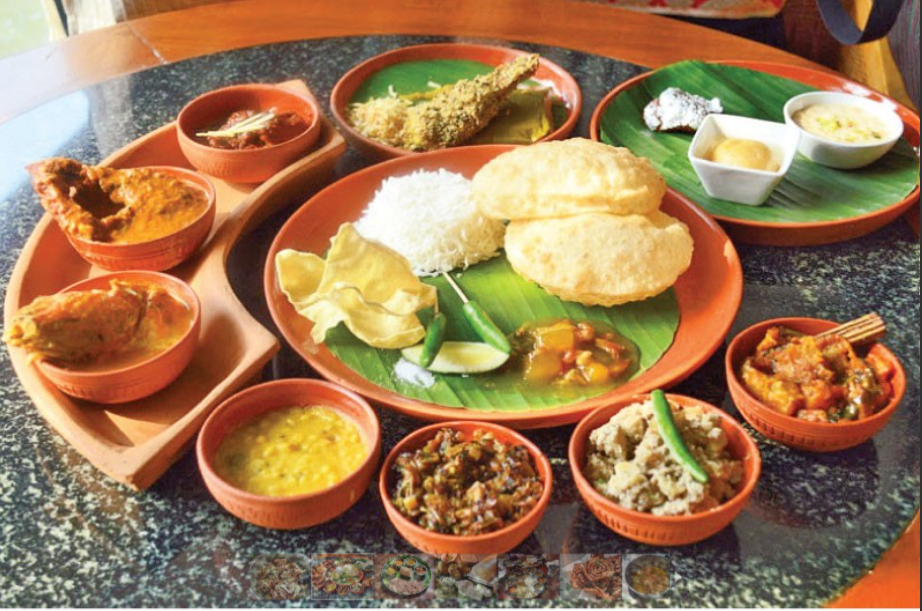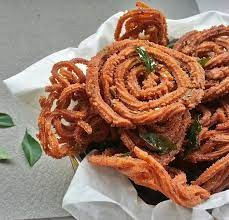"FOOD HABITS OF TAMILS" PART : 35 "இன்றைய தமிழரின் உணவு பழக்கங்கள் தொடர்கிறது" / "Food Habits Of present Tamils continuing" [தமிழிலும் ஆங்கிலத்திலும் / In English and Tamil]
இலங்கை யாழ்ப்பாணத் தமிழர்களின் இன்றைய உணவு முறையை இன்னும் விரிவாகப் பார்த்தால், உங்கள் சிறந்த இடம் வடக்கு மாகாணம், குறிப்பாக யாழ்ப்பாணம், இருப்பினும் இலங்கைத் தீவு முழுவதும் தமிழ்ப் பாணி உணவகங்களைக் காணலாம். தமிழ் மக்கள் இலங்கையில் குறைந்தது கிமு இரண்டாம் நூற்றாண்டிலிருந்தே வாழ்ந்து வருகின்றனர். தென்னிந்தியாவிற்கு மிக அருகில் இருப்பதால், இலங்கைத் தமிழ் உணவு வகைகள், தென் இந்தியா நிலப்பரப்பில் இருந்து நிறைய மசாலாப் பொருட்களைப் பெற்றிருக்கின்றன. யாழ்ப்பாண தீபகற்பத்தைச் சுற்றி ஏராளமான கடல் உணவுகள் உள்ளன, எனவே கோழி அல்லது மாட்டிறைச்சிக்கு பதிலாக, நண்டு, சுறா, மீன் அல்லது இறால் (ஆட்டு இறைச்சியும் மிகவும் பிரபலமானது) ஆகியவற்றால் நிரப்பப்பட்ட மதிய கறியை நீங்கள் அங்கு காணலாம்.
இலங்கையில் நீங்கள் எதிர்பார்ப்பது போல், பெரும்பாலான உணவுகளில் பலவிதமான அச்சாறுகள் (ஊறுகாய்) மற்றும் உலர்ந்த தேங்காய் சம்பல் வழங்கப்படுகிறது. மஞ்சளும் புளியும் இலங்கையில் பெரும்பாலான உணவுகளில் சேர்க்கப் படுகின்றன. எல்லாவற்றையும் கொஞ்சம் கொஞ்சமாகச் சாப்பிட்டுவிட்டு, ஒரு கிண்ண பாலை அல்லது நீரை அருகில் வைத்திருக்க வேண்டும், காரணம் வாயில் உறைப்பை கொஞ்சம் தவிர்க்க. இலங்கையின் வடக்குப் பகுதிகள் பொதுவாக தமிழ் உணவின் 'வீடு' என்று கருதப்பட்டாலும், இலங்கை முழுவதும் தமிழ் உணவைக் காணலாம். கொழும்பில் பல சிறந்த தமிழ் உணவகங்கள் உள்ளன, மேலும் எல்லா இடங்களிலும் யாழ்ப்பாணக் கறியை நீங்கள் காணலாம்.
பொதுவாக ஒரு யாழ்ப்பாணக் கறியை நிறத்தில் இருந்தே சொல்லலாம். இது ஒரு கடும் கருஞ் சிவப்பு நிறத்தைக் கொண்டு உள்ளது. முறையாக தயாரிக்கப்பட்ட யாழ்ப்பாணக் கறியில் கொத்தமல்லி, பெருஞ்சீரகம், வெந்தயம், ஏலக்காய் மற்றும் இலவங்கப்பட்டை உட்பட சுமார் பதினொரு மசாலாப் பொருட்கள் சேர்க்கப் படுகின்றன, ஆனால் முக்கிய மூலப்பொருள் ஒரு பெரிய கைப்பிடி அளவு காய்ந்த சிவப்பு மிளகாய் ஆகும். எல்லாம் தக்காளி மற்றும் தேங்காய்ப் பாலுடன் வேகவைக்கப்படுகிறது, மேலும் உணவு முடிந்த பிறகும் அதன் வாசனை உங்களுடனும் மற்றும் உங்கள் ஆடைகளுடனும் சமையலுக்கு பிறகும் இருக்கும். உள்ளூர்வாசிகள் பொதுவாக இதை ஆடு அல்லது கடல் உணவுகளுடன் பரிமாறுகிறார்கள்.
அப்பம் அல்லது "ஆப்பம்" அதன் பொதுவான பெயரான 'ஹாப்பர்' [‘hopper’] மூலம் உங்களுக்குத் தெரிந்திருக்கலாம். இது ஒரு மிருதுவான, கிண்ணம் போன்ற பான்கேக் [pancake] ஆகும், இது புளித்த அரிசி மாவு மற்றும் தேங்காய் பாலில் இருந்து தயாரிக்கப்படுகிறது, அப்பம் வெள்ளையாப்பம் , பாலாப்பம், முட்டையாப்பம் என பலவகையில் தயாரிக்கப்படும். மேலும் இது தமிழ் உணவு வகைகளின் ஒரு பெரிய பகுதியுமாகும். அவை மெல்லிய துணி அல்லது பான்கேக் போல் இருக்கும். இது வெளியில் மிருதுவாகவும், நடுவில் பஞ்சு போலவும் சிகப்பு மிளகாய் சாம்பலுக்கு ஏற்ற உணவாகவும் உள்ளது. உதாரணமாக, அப்பம் அது சுடப்படும் அப்பச்சட்டி போன்ற வடிவத்தில் வருகிறது. உட்குழிவாக அமையும் அப்பத்தின் நடுவில் முட்டையை உடைத்துப் போட்டுச் சுடும்போது முட்டை அப்பமும் சிறிதளவு தேங்காய்ப் பால் விட்டுச் சுடும்போது பால் அப்பமும் கிடைக்கின்றன. முறுக்கு என்பது சாலையோர டோனட் [doughnut] என்பதற்குச் சமமான ஒரு தமிழ் உணவு ஆகும். இது உளுந்து மாவு, அரிசிமாவு மற்றும் மிளகாய் தூள், உப்பு, சீரகத்துடன் கலந்து, தாவர எண்ணெயில் மிருதுவாக வறுக்கப்பட்ட மொறுமொறுப்பான, காரமான ஒரு பலகாரம் ஆகும். மேலும் முறுக்கிய நிலையில் அச்சு மூலம் பிழியப்படுவதால் முறுக்கு எனப்படுகிறது. யாழ்ப்பாணம் முழுவதிலும் உள்ள சாலையோரக் கடைகளில் அவற்றைக் காணலாம். இதேபோல் புட்டு, இடியாப்பம் போன்ற மற்ற எல்லா உணவுகளும் ஆகும்.
சோறும் கறியும் மதிய உணவாகவும் இரவு உணவாகவும் அதிகமாக உட்கொள்ளப்படுவதுடன், சிறப்பு சந்தர்ப்பங்களிலும் பரிமாறப்படுகின்றன. காலை உணவும் சிலவேளைகளில் இரவு உணவும் அதிகமாக அரிசி மாவினால் அல்லது கோதுமை மாவினால் தயாரிக்கப்பட்ட உணவாக இருக்கின்றன. காலை, மாலை சாப்பாட்டில் தமிழ் நாட்டுக்கும், யாழ்ப்பாணத்துக்கும் இடையே வேறு பாடு காணப்படுகின்றது. தமிழ் நாட்டிலே, இட்லி, தோசை முதலியன முக்கியமான காலை உணவாக இருக்கும் அதே வேளையில், யாழ்ப்பாணத்தில் இடியப்பம், பிட்டு முதலியவையே பெரும்பாலும் உண்ணப்படுகின்றன.
பொதுவாக பிட்டு தேங்காய் சம்பல், சீனிச் சம்பல் மற்றும் பல்வேறு வகையான குழம்புகள் (தக்காளி குழம்பு, கத்தரிக்காய் குழம்பு, வெந்தயக் குழம்பு போன்றவை), காய்கறி, ஆட்டிறைச்சி, கோழி மற்றும் மீன் கறிகளுடன் பரிமாறப்படும். இடியாப்பமும் மேற்சொன்ன பக்க கறிகளுடனும் ஆனால் இடியப்பத்துடன் பயன்படுத்தப்படும் ஒரு முக்கிய பக்க உணவாக தேங்காய்ப் பாலில் வெவ்வேறு காய்கறிகளை வேகவைத்து தயாரிக்கப்படும் சொதி பரிமாறப்படுகிறது. தோசை, இட்லி, சப்பாத்தி மற்றும் உப்புமா ஆகியவை காலை உணவு மற்றும் இரவு உணவாகவும் யாழ்ப்பாணத்தவர் இடையிடையே உண்பது உண்டு. என்றாலும் சப்பாத்தி, உப்புமா மிக அரிதாகவே உட்கொள்ளப் படுகின்றது. தோசை மற்றும் இட்லி பொதுவாக தேங்காய் சட்னி மற்றும் சாம்பாருடன் பரிமாறப்படுகிறது. தமிழ் உணவுகள் தென்னிந்திய உணவு வகைகளைப் போலவே இருந்தாலும், இது பெரும்பாலான தென்னிந்திய உணவுகளை விட அதன் தனித்துவமான சுவை மற்றும் காரம் கொண்டது. பெரும்பாலான இலங்கைத் தமிழ் உணவுகளில் பயன்படுத்தப்படும் தேங்காய்ப் பால் அவற்றிற்கு ஒரு தனிச் சுவையை அளிக்கிறது.
நன்றி :[கந்தையா தில்லைவிநாயகலிங்கம்,
அத்தியடி, யாழ்ப்பாணம்]
பகுதி : 36 தொடரும்..
👉அடுத்த பகுதியை வாசிக்க அழுத்துக
Theebam.com: "தமிழரின் உணவு பழக்கங்கள்"- பகுதி: 36
👉ஆரம்பத்திலிருந்து வாசிக்க அழுத்துக
Theebam.com: "தமிழரின் உணவு பழக்கங்கள்"பகுதி: 01:
"FOOD HABITS OF TAMILS" PART: 35
"Food Habits Of present Tamils continuing"
If we look at the present day diet of Sri Lankan Jaffna
Tamils in more details, your best bet is the northern provinces, and
especially Jaffna, although you’ll find Tamil-style restaurants all over the
island. The Tamil people have lived in Sri Lanka at least since around the
second century BCE. Being so close to southern India, Tamil cuisine borrows a
lot of spices from the mainland. There’s also plenty of seafood around the
Jaffna peninsula, so instead of chicken or beef, you’re more likely to find
your lunch curry stuffed with crab, shark, fish or prawns (goat meat is also
pretty popular).
As you’d expect in Sri Lanka, most meals come with a range of
achars (pickles), and dried coconut sambal. Turmeric and tamarind find their
way into most of your meals. The idea is to eat a little bit of everything, and
keep a glass of milk on stand-by. The northern parts of Sri Lanka are generally
considered the ‘home’ of Tamil cuisine, but you can find Tamil food all over
the country. Colombo has several excellent Tamil restaurants and you’ll spot
Jaffna Curry on menus pretty much everywhere.
You can tell a Jaffna Curry from the colour. It should look
like the promise of future pain: a deep, fiery crimson. There’s about eleven
spices in a proper Jaffna curry, including coriander seeds, fennel seeds,
fenugreek seeds, cardamom and cinnamon, but the key ingredient is a big handful
of dried red chillies. Everything gets simmered with tomato paste and coconut
milk, and the smell will stay with you (and your clothes) long after the meal’s
over. The locals usually serve this one with goat or seafood.
You might know appam by its more common name, ‘hopper’. It’s
a crispy, bowl-like pancake, made from fermented rice batter and coconut milk,
and it’s a big part of Tamil cuisine. Think of them as a more useful crepe:
crispy on the outside and spongey on the middle, the perfect food with red
chilli sambal. Murukku are the Tamil equivalent of roadside doughnuts. Crunchy,
savoury, flash-fried in vegetable oil, and ridiculously moreish. They’re made
from rice flour and urad dal flour, mixed with chilli powder, salt and cumin seeds.
The dough is wrangled into a scraggly, spaghetti-type coil (‘Murukku’ means
twisted in Tamil) and then fried to a crisp. You’ll find them at roadside
stalls all over Jaffna. Similarly all
other menus such as Puttu, Idiappam & etc
Rice and curries are consumed for lunch, dinner and at
special occasions. Break-fast and dinner mainly consists of food prepared from
rice flour or wheat flour. For example Pittu and Idiyappam (called string
hoppers) are the most common food eaten for break-fast and dinner. Normally
Pittu is accompanied by coconut sambol, seeni sambol, and different kind of
gravies (tomato gravy, eggplant gravy, fenugreek gravy etc), vegetable, mutton,
chicken, and fish curries. Idiyappam is also accompanied by the above side
dishes. But one important side dish used with Idiyappam is called Sothi made from boiling different vegetables in
coconut milk. Dosa, idly, chapathis and uppuma are also eaten for break-fast
and dinner occasionally. Dosa and idly are normally served with coconut chutney
and sambar. Even though Tamil cuisine is similar to south Indian cuisine, it
has it’s own distinctive taste and spicier than most south Indian food. Coconut
milk used in most Sri Lankan Tamil dishes gives them a unique flavour.
Thanks:[Kandiah Thillaivinayagalingam,Athiady,
Jaffna]
PART : 36
WILL FOLLOW














0 comments:
Post a Comment